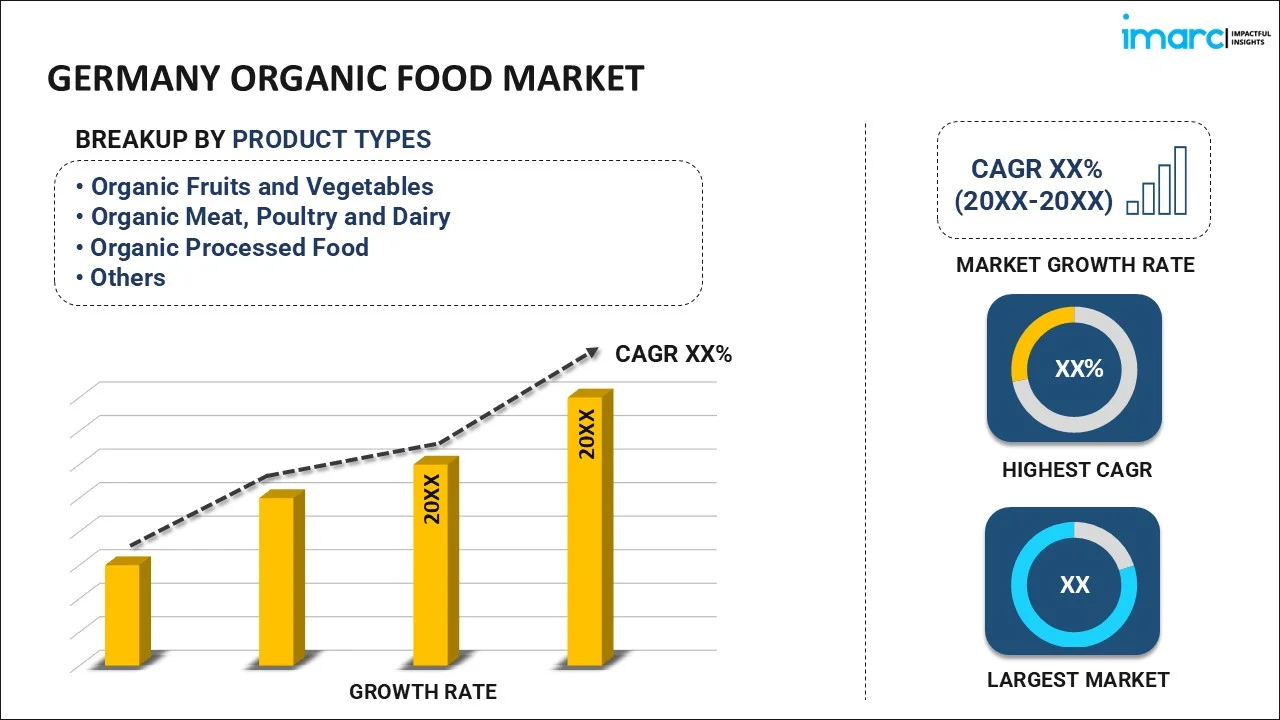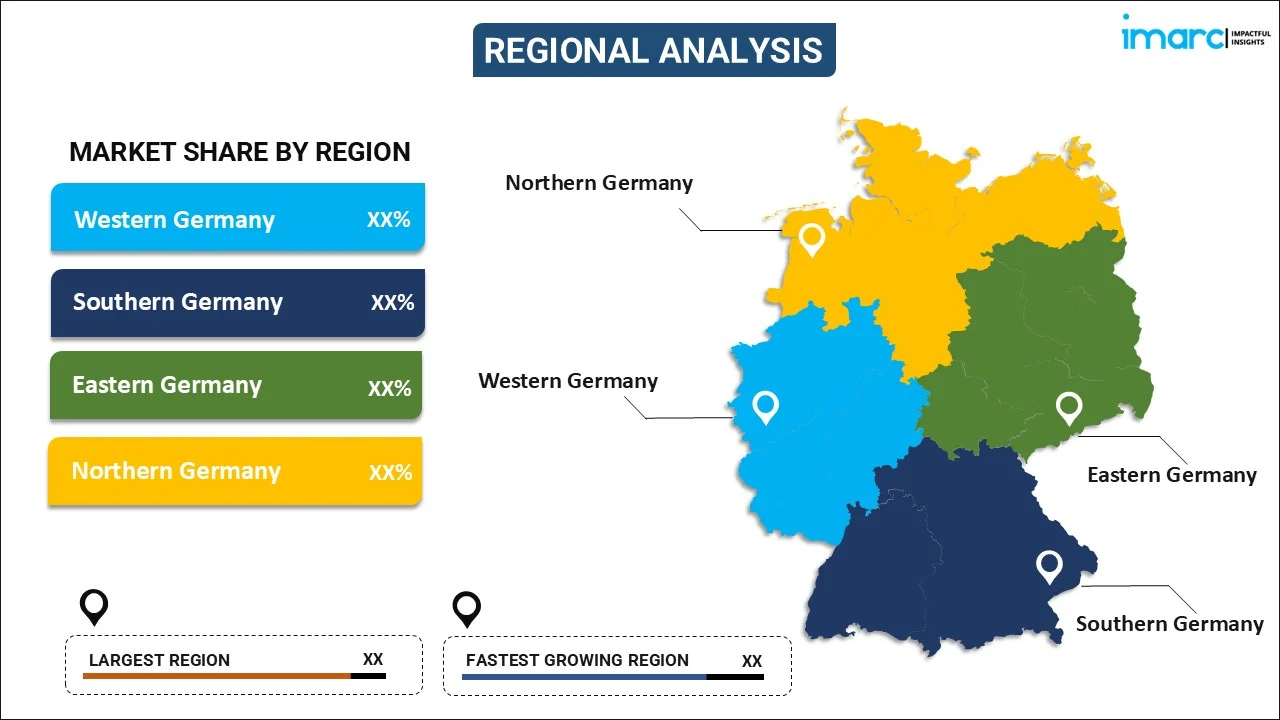
Germany Organic Food Market Size, Share, Trends and Forecast by Product Type, Distribution Channel, Application, and Region, 2025-2033
Germany Organic Food Market Size and Share:
The Germany organic food market size reached USD 8.10 Billion in 2024. Looking forward, IMARC Group expects the market to reach USD 16.50 Billion by 2033, exhibiting a growth rate (CAGR) of 7.40% during 2025-2033. The market is witnessing significant growth mainly driven by the increasing consumer demand for healthier, eco-friendly food products. Government subsidies and policies promoting sustainable agriculture further enhance organic production. The market is also witnessing greater innovation in sustainable sourcing and local farming, which is contributing to the market growth.
|
Report Attribute
|
Key Statistics
|
|---|---|
|
Base Year
|
2024
|
|
Forecast Years
|
2025-2033
|
|
Historical Years
|
2019-2024
|
| Market Size in 2024 | USD 8.10 Billion |
| Market Forecast in 2033 | USD 16.50 Billion |
| Market Growth Rate (2025-2033) | 7.40% |
Germany Organic Food Market Trends:
Government Support for Organic Farming
Germany is proactively backing organic agriculture by providing numerous subsidies and financial incentives designed to promote sustainable farming methods. These efforts encompass direct payments to organic farmers, grants for transforming conventional farms into organic ones, and lowering bureaucratic obstacles to ease the transition. The regulatory authority is additionally advancing organic farming by providing research funding, training initiatives, and awareness efforts that inform both farmers and consumers regarding the advantages of sustainable agriculture. Supportive regulatory frameworks, like enhanced pesticide regulations and rewards for biodiversity-supportive agriculture, correspond with Germany’s wider environmental objectives, which encompass lowering carbon emissions, safeguarding soil vitality, and conserving ecosystems. Furthermore, robust government support plays a vital role in enhancing organic production and satisfying the increasing consumer demand for environmentally friendly and sustainably sourced food. For example, in 2023, the government established bold goals to promote organic farming, intending to dedicate 30% of arable land to organic production by 2030. The Agriculture Ministry took steps to encourage organic products in public entities like schools, hospitals, and government offices, facilitating greater market access. It additionally initiated an informational campaign to increase consumer awareness regarding the advantages of organic food. Moreover, 30% of the agricultural research funding was directed towards organic farming, promoting advancements in sustainable practices and enhancements in productivity.
Expansion of Organic Retail Chains
Germany's organic retail market is witnessing significant expansion as the demand for organic food items increases. Specialized organic food shops and regular supermarkets are increasing their organic selections to meet the needs of health-conscious and environmentally aware shoppers. Retailers are progressively emphasizing locally sourced and sustainably made organic products, in accordance with the nation’s strict environmental and quality regulations. The growth is not confined to physical shops but also includes online platforms, providing customers with enhanced convenience and a broader range of organic food options. Online shopping and direct-to-consumer approaches are becoming increasingly popular, as businesses focus on digital strategies and streamlined supply chains to satisfy demand. Moreover, partnerships between technology-focused agricultural companies and retailers are influencing the organic food market. In August 2023, Swegreen collaborated with EDEKA, a prominent German supermarket chain, along with merchants Stadler & Honner. This partnership signified Swegreen's global growth, launching its inaugural in-store vertical farming facility in Munich, Germany. The program sought to offer consumers ultra-fresh, locally sourced, and pesticide-free fruits and vegetables straight from in-store displays, minimizing transportation emissions and food waste. These initiatives strengthen German retailers' dedication to sustainability, food security, and innovative farming solutions, further propelling the growth of the organic market.
Germany Organic Food Market Segmentation:
IMARC Group provides an analysis of the key trends in each segment of the market, along with forecasts at the regional level for 2025-2033. Our report has categorized the market based on product type, distribution channel, and application.
Product Type Insights:

- Organic Fruits and Vegetables
- Organic Meat, Poultry and Dairy
- Organic Processed Food
- Organic Bread and Bakery
- Organic Beverages
- Organic Cereal and Food Grains
- Others
The report has provided a detailed breakup and analysis of the market based on the product type. This includes organic fruits and vegetables, organic meat, poultry and dairy, organic processed food, organic bread and bakery, organic beverages, organic cereal and food grains, and others.
Distribution Channel Insights:
- Supermarkets and Hypermarkets
- Specialty Stores
- Convenience Stores
- Online Stores
- Others
A detailed breakup and analysis of the market based on the distribution channel have also been provided in the report. This includes supermarkets and hypermarkets, specialty stores, convenience stores, online stores, and others.
Application Insights:
- Bakery and Confectionery
- Ready-to-eat Food Products
- Breakfast Cereals
- Others
A detailed breakup and analysis of the market based on the application have also been provided in the report. This includes bakery and confectionery, ready-to-eat food products, breakfast cereals, and others.
Regional Insights:

- Western Germany
- Southern Germany
- Eastern Germany
- Northern Germany
The report has also provided a comprehensive analysis of all the major regional markets, which include Western Germany, Southern Germany, Eastern Germany, and Northern Germany.
Competitive Landscape:
The market research report has also provided a comprehensive analysis of the competitive landscape. Competitive analysis such as market structure, key player positioning, top winning strategies, competitive dashboard, and company evaluation quadrant has been covered in the report. Also, detailed profiles of all major companies have been provided.
Germany Organic Food Market News:
- In February 2025, BIOFACH 2025, the biggest global trade exhibition for organic food and farming, will take place in Nuremberg, Germany, from February 11-14. The event will showcase innovations in vegan agriculture, sustainable packaging, and ethical products, including Biocyclic Vegan Farming and compostable packaging solutions from Bio4Pack.
- In March 2023, Lidl and Bioland, one of the largest organic food associations in Germany announced an expansion of their partnership aiming to increase organic and Bioland items to make up 10% of Lidl's entire range by 2025. The expansion aimed to strengthen cooperation with local farmers, reduce transport routes and offer high-quality organic products to millions of consumers.
Germany Organic Food Market Report Coverage:
| Report Features | Details |
|---|---|
| Base Year of the Analysis | 2024 |
| Historical Period | 2019-2024 |
| Forecast Period | 2025-2033 |
| Units | Billion USD |
| Scope of the Report |
Exploration of Historical Trends and Market Outlook, Industry Catalysts and Challenges, Segment-Wise Historical and Future Market Assessment:
|
| Product Types Covered | Organic Fruits and Vegetables, Organic Meat, Poultry and Dairy, Organic Processed Food, Organic Bread and Bakery, Organic Beverages, Organic Cereal and Food Grains, Others |
| Distribution Channels Covered | Supermarkets and Hypermarkets, Specialty Stores, Convenience Stores, Online Stores, Others |
| Applications Covered | Bakery and Confectionery, Ready-to-eat Food Products, Breakfast Cereals, Others |
| Regions Covered | Western Germany, Southern Germany, Eastern Germany, Northern Germany |
| Customization Scope | 10% Free Customization |
| Post-Sale Analyst Support | 10-12 Weeks |
| Delivery Format | PDF and Excel through Email (We can also provide the editable version of the report in PPT/Word format on special request) |
Key Questions Answered in This Report:
- How has the Germany organic food market performed so far and how will it perform in the coming years?
- What is the breakup of the Germany organic food market on the basis of product type?
- What is the breakup of the Germany organic food market on the basis of distribution channel?
- What is the breakup of the Germany organic food market on the basis of application?
- What is the breakup of the Germany organic food market on the basis of region?
- What are the various stages in the value chain of the Germany organic food market?
- What are the key driving factors and challenges in the Germany organic food market?
- What is the structure of the Germany organic food market and who are the key players?
- What is the degree of competition in the Germany organic food market?
Key Benefits for Stakeholders:
- IMARC’s industry report offers a comprehensive quantitative analysis of various market segments, historical and current market trends, market forecasts, and dynamics of the Germany organic food market from 2019-2033.
- The research report provides the latest information on the market drivers, challenges, and opportunities in the Germany organic food market.
- Porter's five forces analysis assist stakeholders in assessing the impact of new entrants, competitive rivalry, supplier power, buyer power, and the threat of substitution. It helps stakeholders to analyze the level of competition within the Germany organic food industry and its attractiveness.
- Competitive landscape allows stakeholders to understand their competitive environment and provides an insight into the current positions of key players in the market.
Need more help?
- Speak to our experienced analysts for insights on the current market scenarios.
- Include additional segments and countries to customize the report as per your requirement.
- Gain an unparalleled competitive advantage in your domain by understanding how to utilize the report and positively impacting your operations and revenue.
- For further assistance, please connect with our analysts.
 Request Customization
Request Customization
 Speak to an Analyst
Speak to an Analyst
 Request Brochure
Request Brochure
 Inquire Before Buying
Inquire Before Buying




.webp)




.webp)












